|
|
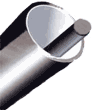 |
|
|
The ConduitPro is
a Microsoft© hosted
Excel™ spreadsheet program that
will assist anyone interested in determining conduit fill capacity, bend
radius and maximum pull tensions for horizontal communications
cabling. The
ConduitPro workbook incorporates eight (8) topic-planning sheets: EIA-Fill,
Peter’s-Fill, Peter's Fill Item#1, Peter's Conduit Fills, Circle
Packing, Square Packing, Fill-Pull-Bend and Conduit Sizes. 1.
The EIA-Fill
Sheet can be used to determine conduit fill and bend radius
per ANSI/TIA/EIA-569 Standard. The user may designate cable internal
diameter and quantity of cables in order to calculate the minimum
conduit size per standard. In addition, conduit minimum bend radius
can be calculated for installation. |
 |
| In the
above example is Item 1, a 2-1/2" EMT conduit would be required
to install 37 - 0.24" OD cables and still be "code compliant". |
| Item
2 allows ConduitPro to calculate how many cables will fit into an existing
standard 2-1/2" EMT conduit. |
 |
| Item
3 below will use the fill parameters to calculate any size conduit
(ID known). The Jam Ratio of 4.7 is calculated to help you determine
possible install problems. |
 |
| The
minimum condeuit bend radius can be calculated for any size conduit. |
 |
2. The Peter’s-Fill Sheet can
be used to determine standard conduit fill and bend radius per the
National Electric Code (NEC) and general code guidelines. The user
may designate cable internal diameters of up to four (4) different
cables [SPECIAL NOTE: We just have added a special
sheet to handle up to ten (10) different cables] and the quantity
of each cable in order to calculate the minimum conduit size
per standard.
In addition,
a
Jam
Ratio (difference
between
cable OD and conduit ID) is provided that lists the potential for 3
or more cables to jam on bends during the installation process. The
user may modify all parameters on all sheets that are color-coded green
(safe to use).
Question: What size conduit is required to house (25-0.25" cables, 30-0.2" cables,
3-0.115" cables and 52-0.3" cables? Answer: a 5" Trade SIze EMT
conduit,
with
a
30.6%
fill and Jam Ratio of 5.4 for the 70 cables |
 |
| Calculations
used in Peter's-Fill Sheet are more exact than the ANSI/TIA/EIA-569
Standard; which does major rounding of the area and Pi. |
| |
Item
2 will allow you to calculate how many cable will fit into a General
EMT trade size conduit.
Peter's Fill Item 2 |
 |
| Item
3 of Peter's Fill will allow calculations for any size ID conduit with
conduit bends |

3. Peter's 10 Cable
Has 10 cable sets
to determine conduit size and fill parameters with conduit bends
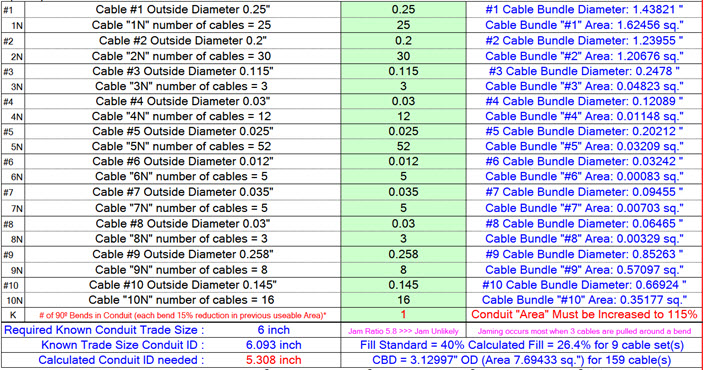
|
4. Peter's
Conduit Fills -
Item 1 has 6 contiguous
conduits and 5 pull boxes to determine: Conduit capacity based on
cable OD
and the cable count. Start with a known cable count and take away cables
at each pull box |




|
Question:
Cable OD is 0.
25", Start with 1200 cables. Take away 71 cables
at box 1, 56 cables at box, 36 cables at box 3, 31 cables at box
4 and 100 cables at box 5.
Conduit A = 14.67" ID, Conduit B = 14.23", Conduit C =
14.23",
Conduit D = 13.899", Conduit E = 13.46" and Conduit F =12.771".
There are 906 left in Conduit F.
Item 2 has
5 stand alone conduit to determine cable fill and conduit requirements
Question: What
are the desired conduit ID's of 0.25" OD cables as follows: Conduit "F" has
15 cables, Conduit "G" has 20 cables, "H"-5, "I"-30
and "J" - 1? |


 |
Answer:
Conduit F = 1.788" ID, Conduit G = 2.025"ID, Conduit H
= 1.068" ID,
Conduit I = 2.45" ID and Conduit J = 0.344" ID
Item 3
Item 3 has 5 contiguous
conduit and 5 pull boxes to add cables to an existing conduit. That
existing conduit may have cables already installed so %-used is provided.


Adding 5 cables doesn't impact the existing 1.394 " ID conduit (fill
% now is 20.9%). The additional 30 cables will reuire a 1.576 " Conduit
ID (Fill is now 40%).
ITEM 4
Item 4 has
a start box (with up to 4 existing cable sets), 3 pull boxes and
4 conduits
(conduit bends, up to 4, are used to calculate the required conduit
ID.
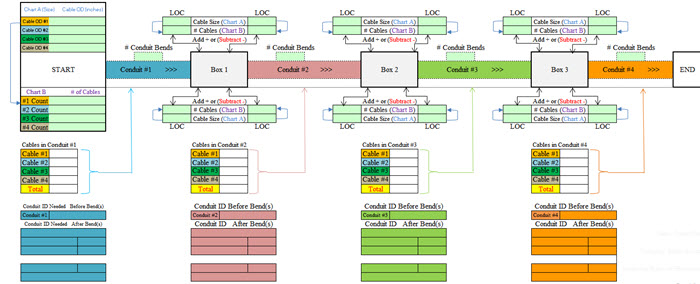
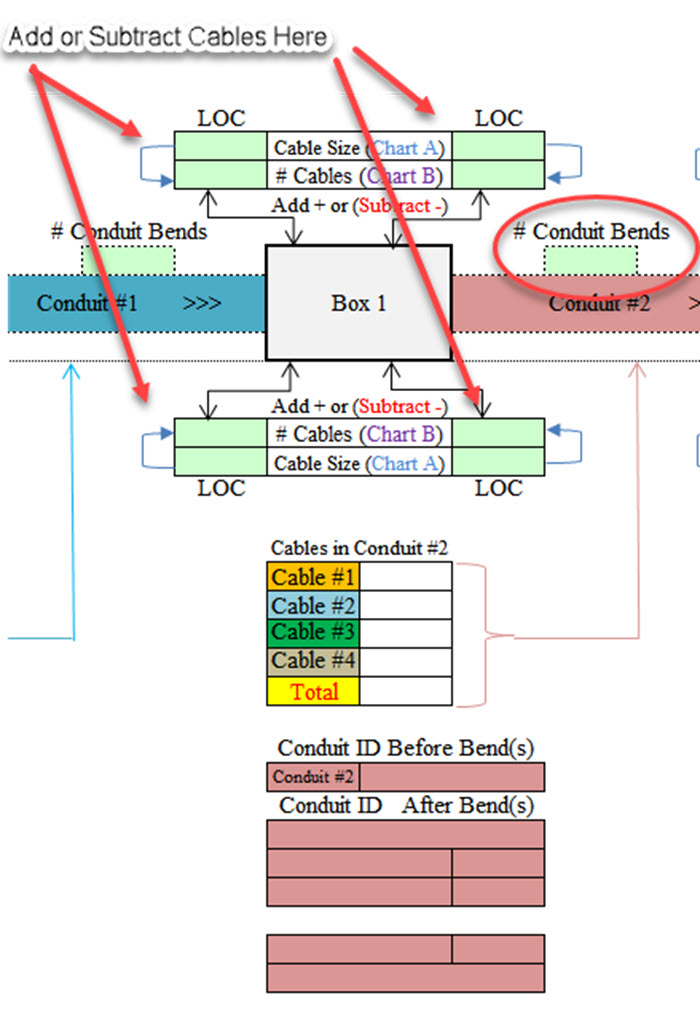
5. The Circle
Sheet has three (3) special subgroups to determine:
Circle Sheet Item 1:
Maximum Cable Count in a conduit based on density packing (near
100% or similar to NASA space packing). |
 |
| Circle
Sheet Item 2: Calculate
the diameter of a tangent cable that will fit between two (2) tangent
cables and a surface. In otherwords, how many cables will fit into conduit? |
 |
| Circle
Sheet Item 3: To
calculate what size conduit is required to fit 3 cables of varying
outside diameters (OD) |
 |
| |
| 6. The Square
Sheet Item 1 has three (3) special subgroups similar to
the Circle
Sheet: |
 |
| Square
Sheet Item
2: To calculate what size cable will fit between 2 cables of known
diameter (all touching each other and a surface) |
 |
Square
Sheet Item
3: To calculate the outside diameter (Cable B) of the cable that
will fit in a square corner between a know diameter cable (Cable
A = 3") touching the
corner
edges. Answer- 1/2 " cable.

|
7. The Fill-Pull-Bend
Sheet also has three (3) special subgroups to determine:
a.
The number of cables that will fit into a cable-management trough |
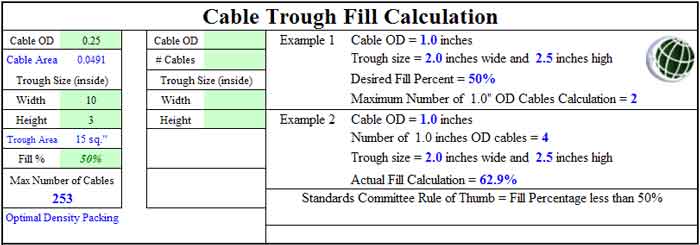 |
| b. The
maximum allowable pulling tension of a solid copper conductor |
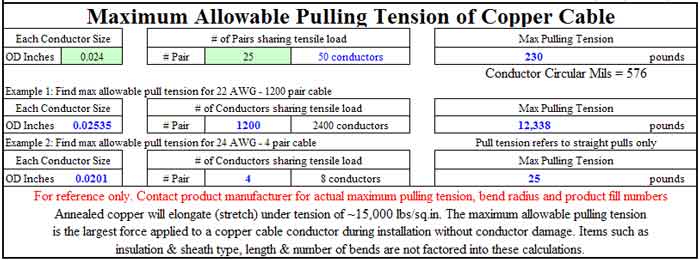 |
c. The
bend radius of communications cable. It is possible to group like conductors
in order to calculate the straight-run pull tension of various cables
such as a 50-pair 22 AWG cable.
In addition, the minimum cable bend radius “Rule of Thumb” is listed for user
perusal. |
8.
The Conduit Size Sheet lists standard conduit sizes,
ranging from ½” to 6”. Standard conduit like EMT, GRC, PVC,
EB and DB are listed for perusal.
Disclaimer:
In all cases, contact the cable/conduit vendor to ascertain exact
dimensions and design information. The manufacture's specifications
and recommendations supercedes any CablePro calculations.
back
to top
©Copyright
2025 BIDQWIK™.COM
All Rights Reserved
No use of information without express written permission|
from Peter Buitenhek
|